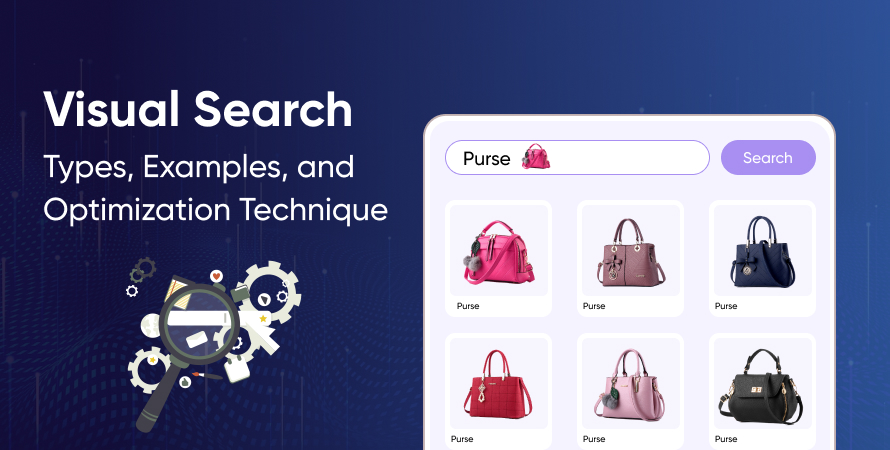Visual Search- Types, Examples, and Optimization Techniques



Visual search is a cutting-edge technology enabling users to search for information using images rather than text. This innovative method leverages AI image search and machine learning to analyze visual content, identify objects, and retrieve related information. By transforming how we interact with technology, visual search is becoming increasingly relevant in the digital age.
Key Takeaways:
Visual search is revolutionizing how we interact with technology and find information online.
In this article, you will learn:
- How visual search works, including the role of AI and machine learning algorithms.
- Differences between visual search Google and traditional image search methods.
- An overview of popular visual search engines and their unique features.
- Real-world applications of visual search technology in various domains.
- Benefits for both users and businesses.
- Best practices for optimizing images for effective visual search results.
- Future trends and innovations shaping the evolution of visual search tools.
How Visual Search Works?
Visual search Bing technology relies on the complex interaction between AI and machine learning algorithms to process image queries and perform object identification. When a user submits an image, these advanced systems analyze the visual content to retrieve relevant information. It is a searching function that uses visual search to enhance effective search experiences.
Core Mechanisms
- Image Processing: The initial step involves converting the image into a data format that AI algorithms can understand. This often entails breaking down the image into recognizable patterns and features.
- Feature Extraction: Key elements such as shapes, colors, and textures are identified. Machine learning models trained on vast datasets can recognize these features and correlate them with specific objects.
- Object Identification: Using convolutional neural networks (CNNs), the system compares the extracted features against a database of labeled images to identify objects within the query image.
- Information Retrieval: Once objects are identified, the system retrieves related information or similar images from its database, presenting results to the user.
Traditional Image Search vs. Visual Search
Traditional Image Search
- Text-Based Queries: Users input text descriptions to find image search.
- Keyword Dependency: Results depend heavily on keywords and metadata associated with images.
- Limitations: Difficulties arise when users lack precise keywords, leading to irrelevant results.
Visual Search
- Image-Based Queries: Users upload or capture images directly.
- Feature Dependency: AI processes visual features rather than relying on text.
Advantages:
- Enhanced Accuracy: Direct visual input reduces ambiguity, enhancing object identification accuracy.
- User Convenience: Simplifies search for users who can’t articulate their needs in words.
Example Comparison
Imagine a scenario where a user wants to find a unique piece of furniture, they saw but doesn’t know what it’s called. With traditional Bing picture search, they might struggle with vague terms like “modern chair with curved legs,” yielding mixed results. Using Google Search Visual, they upload an image of the chair, enabling the algorithm to identify it accurately and provide matching items or detailed information instantly. This capability underlines how visual search transforms user interactions by using artificial intelligence image search technologies for precise and intuitive information retrieval.
Popular Visual Search Engines and Their Unique Features
1. Google Lens
Google Lens is a leading visual search tool that lets users point their smartphone camera at an object to instantly get information about it. Here are its key features:
- Object Identification: Recognizes objects, landmarks, plants, and animals.
- Text Translation: Translates text in real-time.
- Product Search: Find products online by scanning barcodes or taking pictures.
2. Bing Visual Search
Developed by Microsoft, Bing Visual Search offers a powerful visual search experience with some unique features:
- Integrated Shopping Experience: Users can shop for items directly from image search options.
- Similar Images Finder: Bing photo search helps users find visually similar images across the web.
- Detailed Object Recognition: Bing search with image identifies multiple objects within a single image.
3. Pinterest Lens
Leveraging Pinterest’s vast visual database, Pinterest Lens provides a rich visual search experience with the following capabilities:
- Discover Ideas and Inspirations: Matches images with pins on similar topics or themes.
- Shop Pins: Directs users to purchase options for items found in images.
- Style and Decor Suggestions: Offers style tips based on scanned images.
4. Amazon Lens
Integrated into the Amazon app, Amazon Lens focuses on enhancing shopping experiences with these notable features:
- Product Scanning: Quickly scans products to find them on Amazon.
- Price Comparisons: Compares prices between scanned items and Amazon listings.
- User Reviews Access: Provides access to user reviews and ratings.
These visual search engines each bring distinct capabilities, catering to various user needs and preferences in the digital age.
Real-World Applications of Visual Search Technology
Visual search technology has found practical applications across various domains, changing the way users interact with digital content and businesses operate.
E-Commerce
In the world of online shopping, visual search makes it easier for customers to find products. They can upload pictures or screenshots of things they like and get instant recommendations for similar items available on the retailer’s website. For instance, Amazon Lens lets users scan real-life objects to locate product listings, making the shopping process smoother and boosting sales.
Fashion
Fashion brands use visual search to assist customers in finding clothing and accessories that fit their preferred style. By simply taking a picture of an outfit they admire, users can discover similar pieces within the brand’s collection. Pinterest Lens is particularly popular in this area, allowing fashion lovers to effortlessly explore and buy new looks.
Travel
In the travel industry, visual search helps identify landmarks and attractions. Tourists can capture an image of a monument or picturesque location, and tools like Google Lens offer comprehensive details about it. This feature enhances the travel experience by providing historical context and suggesting travel tips based on visual input.
Home Decor
Home decor companies utilize visual search to enable customers to discover furniture and decor items that align with their design preferences. Users can upload pictures of their living spaces, and visual search engines recommend complementary pieces from the retailer’s collection. This personalized approach not only improves user satisfaction but also boosts sales.
Automotive Industry
Car manufacturers integrate visual search into their applications to help users identify car models and parts. By snapping a photo of a vehicle or component, users can access detailed specifications, reviews, and purchasing options.
Healthcare
In healthcare, visual search supports medical professionals in diagnosing conditions through images. AI-powered tools analyze patient scans or photographs to detect diseases and suggest treatment plans. This application enhances diagnostic precision and improves patient outcomes.
These diverse applications demonstrate how visual search technology is transforming user experiences across various sectors by providing intuitive, efficient solutions for discovering relevant information and products.
Benefits for Users and Businesses Alike
Adopting visual search solutions offers numerous advantages for both users and businesses:
User Benefits of Visual Search
- Improved Object Identification: Visual search provides accurate identification of objects within images, enabling users to quickly find information or products without needing detailed descriptions.
- Enhanced User Experience: By allowing intuitive searching through images, users enjoy a more engaging and efficient way to discover content.
- Accessibility: Visual search can assist users who may struggle with text-based searches, making technology more inclusive.
Business Benefits of Visual Search
- Higher Conversion Rates: E-commerce businesses see increased conversion rates as visual search simplifies product discovery, helping customers find exactly what they’re looking for.
- Increased Brand Awareness: Brands can leverage visual search to highlight their products when users search for similar items, boosting visibility.
- Better Customer Insights: Analyzing visual search data provides valuable insights into customer preferences and behavior, enabling businesses to tailor their offerings effectively.
Visual search bridges the gap between visual content and user intent, creating a seamless interaction that benefits all parties involved.
Optimizing Images for Effective Visual Search Results
Effective image optimization is crucial for enhancing visibility in visual search results. Here are several best practices that website owners should follow:
- High-Quality Images: Use clear, high-resolution images to ensure that visual search engines can accurately analyze and identify objects. Choose the correct format—JPEG for photographs and PNG for graphics.
- Descriptive File Names: Assign relevant and descriptive names to image files. Instead of generic names like IMG_1234.jpg, use specific names such as red-leather-handbag.jpg.
- Alt Text: Add detailed alt text to each image. This not only improves accessibility but also helps search engines understand the content of the image.
- Structured Data Markup: Implement structured data (Schema.org) to provide additional context about the images. This helps search engines index images more effectively.
- Image Sitemaps: Create a dedicated sitemap for images or integrate image tags within your existing sitemap to assist search engines in discovering and indexing your visual content.
- Responsive Design: Ensure that images are optimized for various devices by employing responsive design techniques. This includes using appropriate sizes and ensuring fast loading times on mobile devices.
- Focus on Main Objects: Crop and frame images to focus on the main object, making it easier for visual search algorithms to process and identify key elements.
By adhering to these image optimization techniques for visual search, website owners can significantly improve their chances of appearing in visual search results, which can lead to increased traffic and engagement.
The Future of Visual Search Technology
Future developments in search engine visual technology are paving the way for more sophisticated and intuitive tools. Notably, several emerging trends are shaping this evolution:
1. Augmented Reality (AR) Integration
AR is being increasingly incorporated into visual search applications. This allows users to overlay digital information on the real world, enhancing their interaction with physical objects.
2. Advancements in Deep Learning Models
Enhanced deep learning algorithms are improving image recognition tasks. These models can now identify objects with greater accuracy, even in complex or cluttered environments.
3. Voice-Activated Visual Search
Combining voice search with visual search capabilities is becoming more prevalent. Users can now describe what they see verbally and get accurate visual search results.
4. Contextual Understanding
New models aim to understand the context around objects in images, providing more relevant and useful search results.
These innovations promise to make visual.look up search an indispensable tool across various industries, delivering richer and more engaging user experiences.
Conclusion
Visual Google search is a rapidly evolving technology that leverages images to facilitate and enhance search experiences. Understanding its various types, from traditional image-based searches to advanced AI-driven models, provides insight into its potential applications.
Real-world visual examples demonstrate its effectiveness in e-commerce, social media, and more. By implementing optimization techniques such as high-quality images, accurate metadata, and schema markup, businesses can significantly improve their visibility and user engagement in the visual search landscape. Embracing these strategies ensures staying competitive and meeting the growing demand for efficient and intuitive search experiences.